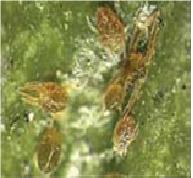|
Pests of Citrus :: Minor Pests:: Citrus leaf mite
14. Citrus leaf mite: Eutetranychus orientalis (Tetranychidae: Acari)
Distribution and status : Afghanistan, Cyprus, Taiwan, Egypt, India, Iran, Israel, Jordan, Kenya, Lebanon, Mozambique, Pakistan, Sudan, Turkey and Venezuela. Serious pest in lower altitudes.
Host range
Citrus species, Cassia fistula, castor, Cannabis sp., Nerium oleander, neem, Dalbergia sisso, Indian coral tree, papaya, almond, peach, pear and curry-leaf .
Bionomics
It passes through egg, larva, protonymph, deutonymph and adult stages. Average fecundity per female is 51.3 eggs and egg period is 5 days. Larval, protonymphal and deutonymphal periods are 1.41, 1.50 and 1.50 days respectively. Total developmental stage from egg to adult 12-13 days. It develops faster on leaves of castor, French bean and lime than on mandarin. Peak population found during March-June and September-October. |

|
|
| |
|
Damage symptoms
Mites suck the sap of leaves predominantly from the upper surface of leaves; the affected leaves turn chlorotic and finally drop off resulting in poor plant growth. Infestation starts along the midrib of leaves and later spreads along lateral veins, as a result the region on either side of the midrib and veins turn pale-yellow. In case of severe mite infestation, the upper leaf surface turns pale completely. The webbing produced by the mite trap dust particles, hence the infested leaves are covered with fine dust particles. However, the lower surface remains free of mites and their feeding injury, and appears normal green. In some cases, mite infested fruits also appear chlorotic.
Management
- Prefer relatively resistant Citron (Citrus medica), lime variety kagzi lime, C. sinensis, C. aurantifolia and sweet orange
- Avoid sour lemon variety, sweet lime (C. limmetioides), Kharna khattai, grape fruit and Citrus acida as they are most susceptible
- Select resistant root stock Citrus aurantiifolia followed by Citrus reshini and C. amblycarpa
- Remove alternate host plants like castor, echandinii, amaltas (Cassia fistula), Melia sp., in orchards.
- Irrigate judiciously, particularly during summer to prevent water stress conditions and resultant flare up
- Conserve coccinellid beetles viz., Scymnus gracilis, Stethorus pauperculus and predatory thrips viz., Scolothrips, predatory mites viz., Amblyseius cucumeris, A. hibisci, Pronematus sp. and Agistemus sp.
Apply aldicarb 10 G 5 g /nursery plant or Spray any of the insecticides viz.,dicofol 18.5 EC, fenpropathrin 10 EC, monocrotophos 36 SL, methyl demeton 25 EC, wettable sulphur 3 g/L, permethrin 25 EC 1.0 L in 1000 L of water /h |
|
